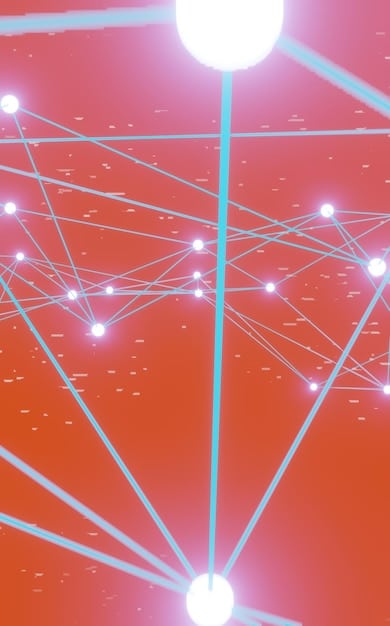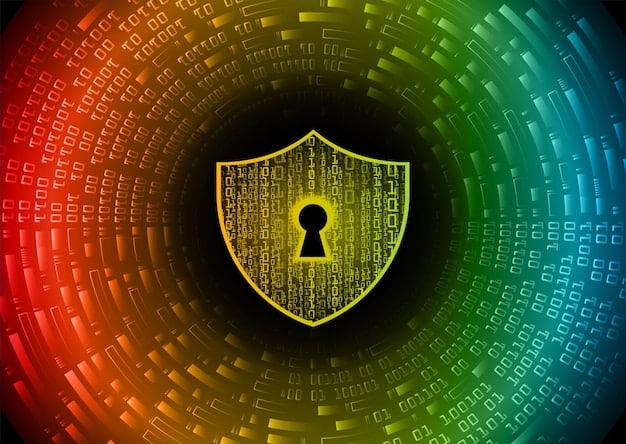The Dark Web: Risks & How to Protect Your Identity

The Dark Web presents significant risks, including exposure to illegal content, malware, and identity theft; understanding these dangers and implementing robust protective measures is crucial for safeguarding your personal information and maintaining online security.
Navigating the internet’s hidden corners, like the Dark Web: Understanding the Risks and How to Protect Your Identity, requires awareness and caution. This guide will shed light on what the dark web is, the dangers it poses, and how you can safeguard your online presence.
What is the Dark Web?
What exactly is the Dark Web? It’s a part of the internet that isn’t indexed by standard search engines, making it difficult to find without specific software and knowledge. Understanding its structure is key to grasping the risks involved.
The Dark Web is a subset of the Deep Web, which refers to any part of the internet that isn’t indexed by search engines. Imagine the internet as an iceberg; the surface web, what you access daily through Google, is just the tip. The Deep Web is everything below the surface, including online banking portals, subscription websites, and private databases. The dark web is a small portion of the Deep Web, characterized by its anonymity and often illicit content.
Key Characteristics of the Dark Web
Several features distinguish the dark web from the surface web. These characteristics contribute to its unique environment and associated risks.
- Anonymity: The dark web relies on anonymity networks like Tor (The Onion Router) to mask users’ IP addresses, making it difficult to trace online activity.
- Decentralization: Unlike the centralized structure of the surface web, the dark web is decentralized, with no single point of control.
- Unindexed Content: Dark web sites are not indexed by search engines, requiring specific URLs and software to access them.
- Hidden Services: Sites on the dark web often operate as “hidden services,” with obscured locations and identities.
The dark web’s appeal stems from its promise of privacy, but this anonymity also attracts illegal activities. Understanding these characteristics is crucial for anyone considering venturing into this digital realm.

Common Risks Associated with the Dark Web
The dark web teems with risks that every user needs to be aware of. From malware to illegal content, the dangers are significant and can have serious consequences.
One of the primary risks is exposure to illegal and harmful content. Marketplaces for illegal drugs, weapons, and stolen data are prevalent. Simply browsing these sites can expose you to disturbing images and potentially illegal material. Moreover, many sites on the dark web host malware, viruses, and phishing scams designed to steal your personal information.
Specific Dangers on the Dark Web
Here’s a closer look at some of the most common threats lurking on the dark web.
- Malware and Viruses: Downloading files from untrusted sources can infect your device with malware, leading to data theft or system damage.
- Identity Theft: The dark web is a marketplace for stolen personal information, including credit card numbers, social security numbers, and login credentials.
- Scams and Fraud: Many sites on the dark web are designed to scam users out of money or personal information.
- Exposure to Illegal Content: Accessing or downloading illegal content can lead to legal repercussions.
Navigating the dark web without taking proper precautions can put you at significant risk. Understanding and mitigating these threats is essential for protecting your digital identity and security.
How to Protect Your Identity on the Dark Web
Protecting your identity on the dark web requires a multi-layered approach. From using strong passwords to enabling two-factor authentication, several strategies can enhance your security.
One fundamental step is using a virtual private network (VPN) to encrypt your internet connection and mask your IP address. This adds an extra layer of anonymity, making it harder to trace your online activity. Additionally, avoid using your real email address when accessing the dark web; instead, create a separate, anonymous email account specifically for this purpose. Do not reuse passwords from other accounts, and consider using a password manager to generate and store strong, unique passwords.
Essential Security Measures
Here are some detailed security measures to consider when accessing the dark web.
- Use a VPN: Encrypt your internet connection and mask your IP address.
- Create an Anonymous Email: Use a separate, anonymous email account.
- Strong, Unique Passwords: Use a password manager to generate and store strong passwords.
- Two-Factor Authentication: Enable two-factor authentication whenever possible.
Furthermore, be extremely cautious about downloading files or clicking on links from untrusted sources. Always use a reputable antivirus program and keep it updated. Regular monitoring of your credit report and financial accounts can help detect and address any potential identity theft issues.

Best Practices for Safe Dark Web Browsing
Safe browsing on the dark web involves more than just technical tools; it requires a cautious and informed mindset. By following certain practices, you can minimize your risk exposure.
First and foremost, limit your time spent on the dark web and only access sites when absolutely necessary. Avoid engaging in any transactions or sharing personal information. Be wary of sites that seem too good to be true, as they are often scams. Before accessing a site, research its reputation and credibility. Look for reviews or warnings from other users.
Remember, even with the best security measures, there is always a risk involved. Staying informed about new threats and adapting your security practices accordingly is crucial for maintaining your safety.
Legal Implications of Accessing the Dark Web
Understanding the legal implications of accessing the dark web is essential. While simply browsing the dark web is not illegal in many jurisdictions, engaging in certain activities can have serious legal consequences.
Accessing or distributing illegal content, such as child pornography, drug trafficking, or weapons sales, is strictly prohibited and can result in severe penalties. Even unknowingly accessing illegal material can lead to legal issues if authorities trace your activity. Be aware that law enforcement agencies actively monitor the dark web and conduct operations to identify and prosecute individuals involved in illegal activities.
Future of the Dark Web and Online Privacy
As technology evolves, so too does the landscape of the dark web and online privacy. Staying informed about emerging trends and security measures is crucial for protecting your digital identity in the future.
The future of the dark web will likely involve increased sophistication in anonymity technologies and encryption methods. As governments and law enforcement agencies become more adept at tracking online activity, users of the dark web will seek more advanced tools to protect their privacy. This could lead to an arms race between those seeking anonymity and those seeking to pierce it.
Conclusion
The dark web presents a complex and ever-evolving landscape of risks and opportunities. By understanding the inherent dangers and taking proactive steps to protect your identity, you can navigate this digital realm with greater confidence. Stay informed, stay vigilant, and prioritize your online security.
| Key Point | Brief Description |
|---|---|
| 🔒 Anonymity | The dark web uses tools like Tor to mask user identities, making activities hard to trace. |
| ⚠️ Risks | Malware, illegal content, and identity theft are common dangers on the dark web. |
| 🛡️ Protection | Using VPNs, strong passwords, and anonymous emails can protect your identity. |
| ⚖️ Legality | Accessing illegal content on the dark web leads to legal issues. |
Frequently Asked Questions
▼
The deep web includes any content not indexed by search engines, like banking portals. The dark web is a subset of the deep web, known for requiring special software for access and often hosting illicit content.
▼
Simply accessing the dark web is not illegal in most places, but any illegal activities conducted or accessed there could lead to severe legal consequences.
▼
Use a VPN, create anonymous email, use strong, unique passwords, enable two-factor authentication and avoid downloading any files from untrusted sources.
▼
The dark web offers heightened anonymity via the Tor browser, which is appealing to criminals seeking to hide their identities and avoid detection by authorities.
▼
A VPN (Virtual Private Network) encrypts your internet connection and masks your IP address, providing an added layer of anonymity, which is crucial for safe dark web browsing.
Conclusion
Protecting your digital identity on the dark web requires an understanding of its risks and tools, such as VPNs and strong passwords. By staying informed and cautious, you can minimize your risk and enhance online security.





